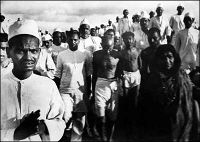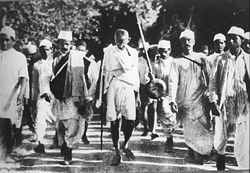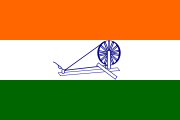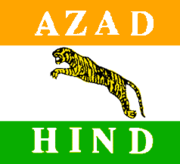Bal Gangadhar Tilak
Bal Gangadhar Tilak (Marathi: बाळ गंगाधर टिळक Born as Keshav Gangadhar Tilak) 23 July 1856–1 August 1920 (aged 64), was an Indian nationalist, teacher, social reformer and independence fighter who was the first popular leader of the Indian Independence Movement. The British colonial authorities derogatorily called the great leader as "Father of the Indian unrest". He was also conferred upon the honorary title of Lokmanya, which literally means "Accepted by the people (as their leader)". Tilak was one of the first and strongest advocates of "Swaraj" (self-rule) in Indian consciousness. His famous quote, "Swaraj is my birthright, and I shall have it !" is well-remembered in India even today.
Contents |
Early life
Tilak was born in Chikhaliin Ratnagiri, Maharashtra, into a Chitpavan Brahmin family. His father was a famous schoolteacher and a Sanskrit scholar. He died when Tilak was sixteen. His brilliance rubbed off on young Tilak, who graduated from Deccan College, Pune in 1877. Tilak was among one of the first generation of Indians to receive a college education.[1]
Tilak was expected, as was the tradition then, to actively participate in public affairs. He believed that “Religion and practical life are not different. To take to Sanyasa (renunciation) is not to abandon life. The real spirit is to make the country your family instead of working only for your own. The step beyond is to serve humanity and the next step is to serve God.” This dedication to humanity would be a fundamental element in the Indian Nationalist movement.[2]
After graduating, Tilak began teaching mathematics in a private school in Pune. Later due to some philosophical differences with the colleagues in the New School, he decided to withdraw from that activity. In that time frame he became a journalist. He was a strong critic of the Western education system, feeling it demeaned the Indian students and disrespected India's heritage. He organized the Deccan Education Society with a few of his college friends, including Gopal Ganesh Agarkar, Mahadev Ballal Namjoshi and Vishnu Krishna Chiplunkar whose goal was to improve the quality of education for India's youth. The Deccan Education Society was set up to create a new system that taught young Indians nationalist ideas through an emphasis on Indian culture.[3] Tilak began a mass movement towards independence that was camouflaged by an emphasis on a religious and cultural revival.[4] He taught Mathematics at Fergusson College.
Political career
Journalism
Tilak co-founded two newspapers with Gopal Ganesh Agarkar, Vishnushastri Chiplunkar and other colleagues: Kesari, which means "Lion" in Sanskrit and was a Marathi newspaper, and 'The Maratha', an English newspaper in 1881. In just two years 'Kesari' attracted more readers than any other language newspaper in India. The editorials were generally about the people's sufferings under the British. These newspapers called upon every Indian to fight for his or her rights. Tilak used to say to his colleagues: "You are not writing for the university students. Imagine you are talking to a villager. Be sure of your facts. Let your words be clear as daylight."
Tilak strongly criticized the government for its brutality in suppressing free expression, especially in the face of protests against the division of Bengal in 1905, and for denigrating India's culture, its people and heritage. He demanded that the British immediately give Indians the right to self-government.
Indian National Congress
Tilak joined the Indian National Congress in 1890. He opposed its moderate attitude, especially towards the fight for self government.
In 1891 Tilak opposed the Age of Consent bill. The act raised the age at which a girl could get married from 10 to 12. The Congress and other liberals supported it, but Tilak was set against it, terming it an interference with Hinduism. However, he personally opposed child marriage, and his own daughters married at 16.
A plague epidemic spread from Mumbai to Pune in late 1896, and by January 1897, it reached epidemic proportions. In order to suppress the epidemic and prevent its spread, it was decided to take drastic action, accordingly a Special Plague Committee, with jurisdiction over Pune city, its suburbs and Pune cantonment was appointed under the Chairmanship of W. C. Ranade, I. C. S, Assistant Collector of Pune by way of a government order dated 8 March 1897. On 12 March 1897, 893 officers and men both British and native, under command of a Major Paget of the Durham Light Infantry were placed on plague duty. By the end of May the epidemic had ebbed and the military action was gradually ended. In his report on the administration of the Pune plague, Rand wrote, "It is a matter of great satisfaction to the members of the Plague Committee that no credible complaint that the modesty of a woman had been intentionally insulted was made either to themselves or to the officers under whom the troops worked". He also writes that closest watch was kept on the troops employed on plague duty and utmost consideration was shown for the customs and traditions of the people.[5][6] Indian sources however report that Rand used tyrannical methods and harassed the people.[7] An account based on local Indian sources writes that the appointment of military officers introduced an element of severity and coercion in the house searches, the highhandedness of the government provoked the people of Pune and some soldiers were beaten in Rastapeth locality. It quotes Kelkar[nb 1] on the conduct of British soldiers, "Either, through ignorance or impudence, they would mock, indulge in monkey tricks, talk foolishly, intimidate, touch innocent people, shove them, enter any place without justification, pocket valuable items, etc.."[9] Tilak took up the people's cause by publishing inflammatory articles in his paper Kesari, quoting the Hindu scripture, the Bhagavad Gita, to say that no blame could be attached to anyone who killed an oppressor without any thought of reward. Following this, on 22 June, Rand and another British officer Lt. Ayerst were shot and killed by the Chapekar brothers and their other associates. Tilak was charged with incitement to murder and sentenced to 18 months' imprisonment. When he emerged from prison, he was revered as a martyr and a national hero and adopted a new slogan, "Swaraj (Self-Rule) is my birth right and I will have it."
Following the partition of Bengal in 1905, which was a strategy set out by Lord Curzon to weaken the nationalist movement, Tilak encouraged a boycott, regarded as the Swadeshi movement.[10]
Tilak opposed the moderate views of Gopal Krishna Gokhale, and was supported by fellow Indian nationalists Bipin Chandra Pal in Bengal and Lala Lajpat Rai in Punjab. They were referred to as the Lal-Bal-Pal triumvirate. In 1907, the annual session of the Congress Party was held at Surat (Gujarat). Trouble broke out between the moderate and the extremist factions of the party over the selection of the new president of the Congress. The party split into the "Jahal matavadi" ("Hot Faction," or extremists), led by Tilak, Pal and Lajpat Rai, and the "Maval matavadi"("Soft Faction," or moderates).
Arrest
On 30 April 1908 two Bengali youths, Prafulla Chaki and Kudiram Bose, threw a bomb on a carriage at Muzzafurpur in order to kill the Chief Presidency Magistrate Douglas Kingsford of Calcutta fame, but erroneously killed some women travelling in it. While Chaki committed suicide when caught, Bose was tried and hanged. Tilak in his paper Kesari defended the revolutionaries and called for immediate Swaraj or Self-rule. The Government swiftly arrested him for sedition. He asked a young Muhammad Ali Jinnah to represent him. But the British judge convicted him and he was imprisoned from 1908 to 1914 in the Mandalay Prison, Burma.[11] While imprisoned, he continued to read and write, further developing his ideas on the Indian Nationalist movement.
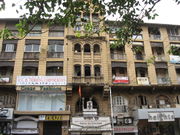
Much has been said of his trial of 1908, it being the most historic trial. His last words on the verdict of the Jury were such: "In spite of the verdict of the Jury, I maintain that I am innocent. There are higher powers that rule the destiny of men and nations and it may be the will of providence that the cause which I represent may prosper more by my suffering than by my remaining free". These words now can be seen imprinted on the wall of Room. No. 46 at Bombay High Court.
Life after prison
Tilak had mellowed after his release in June 1914. When World war I started in August, Tilak, cabled the King-Emperor in Britain of his support and turned his oratory to find new recruits for war efforts. He welcomed The Indian Councils Act, popularly known as Minto-Morley Reforms which had been passed by British parliament in May 1909 terming it as ‘a marked increase of confidence between the Rulers and the Ruled’. Acts of violence actually retarded than hastened the pace of political reforms, he felt. He was eager for reconciliation with Congress and had abandoned his demand for direct action and settled for agitations ‘strictly by constitutional means’ - a line advocated by his rival Gopal Krishna Gokhale.
All India Home Rule League
Later, Tilak re-united with his fellow nationalists and re-joined the Indian National Congress in 1916. He also helped found the All India Home Rule League in 1916-18 with Joseph Baptista, Annie Besant, G. S. Khaparde and Muhammad Ali Jinnah. After years of trying to reunite the moderate and radical factions, he gave up and focused on the Home Rule League, which sought self-rule. Tilak travelled from village to village trying to conjure up support from farmers and locals to join the movement towards self-rule.[11] Tilak was impressed by the Russian Revolution, and expressed his admiration for Lenin.[12]
Tilak, who started his political life as a Maratha protagonist, during his later part of life progressed into a prominent nationalist after his close association with Indian nationalists following the partition of Bengal. When asked in Calcutta whether he envisioned a Maratha type of government for Free India, Tilak replied that the Maratha dominated Governments of 17th and 18th centuries were outmoded in 20th century and he wanted a genuine federal system for Free India where every religion and race were equal partners. He added that only such a form of Government would be able to safeguard India's freedom. He was the first Congress leader to suggest that Hindi written in the devanagari script, should be accepted as the sole national language of India.
Social contribution
In 1894, Tilak transformed household worshipping of Ganesha into Sarvajanik Ganeshotsav and he also made Shiva Jayanti(birth anniversary celebrations of Chhatrapati Shivaji Maharaj) as a social festival. It is touted to be an effective demonstration of festival procession. Gopal Ganesh Agarkar was the first editor of Kesari, a prominent Marathi weekly in his days which was started by Lokmanya Tilak in 1880-81. Gopal Ganesh Agarkar subsequently left Kesari out of ideological differences with Bal Gangadhar Tilak concerning the primacy of political reforms versus social reforms, and Gopal Ganesh Agarkar started his own periodical Sudharak.
Later years and legacy
After Tilak’s death on August 1, 1920, on the first day of Gandhi’s first non-cooperation campaign,[11] Gandhi paid his respects at his cremation in Mumbai, along with 20 people. Gandhi called Tilak "The Maker of Modern India".. To that effect, perhaps Tilak's personality bore resemblance to that of Benjamin Franklin. Both were early activists in independence movements of their respective countries. Both were multi-faceted (while Tilak was accomplished as a teacher, editor and dabbled in scientific thought, Franklin's technological contributions besides political thought are well-known), talented and contributed in shaping a modern identity of the group of people that they belonged to. It is conceivable that Tilak was aware of Benjamin Franklin's contribution to the American Revolution and culture during his time. Most importantly, both strove to achieve self-discipline, highly ethical and moral behavior deriving from their religious and cultural backgrounds while also modifying the same to suit modern sensibilities of the time. Franklin's thirteen virtues are well known. Tilak exhibited and worked towards achieving personal, moral, ethical, mental and physical strength by practicing what seemed necessary to him at the time.
The court which convicted Tilak bears a plaque that says, "The actions of Tilak has been justified as the right of every individual to fight for his country. Those two convictions have gone into oblivion -- oblivion reserved by history for all unworthy deeds". The Bhartiya Janta Party BJP is believed to get its inspiration from Lokmanya Tilak and also considers Tilak as its Halo.
Books
In 1903, he wrote the book The Arctic Home in the Vedas. In it he argued that the Vedas could only have been composed in the Arctics, and the Aryan bards brought them south after the onset of the last Ice age. He proposed the radically new way to determine the exact time of Vedas. Up to that time, antiquity of Vedas was mostly decided by the form of the language used in it . He tried to calculate the time of Vedas by using the position of different Nakshatras. Positions of Nakshtras were described in different Vedas. Knowing the motion of Nakshtras and their positions (at the time of Vedas and current) we can calculate the time of Vedas. Sri Tilak found that the vedas were written around 4500 B.C. , when the Vernal equinox was in the constellation of Mṛiga or Orion during the period of the Vedic hymns, and that it had receded to the constellation of the Kṛittikâs, or the Pleiades (about 2500 B.C.) in the days of the Brâhmanas. This was his basic idea. This idea was criticized by some scholars,[Who?] praised by some others[Who?]. But originality and charm of this new way of looking towards this problem was largely accepted.
Tilak also authored 'Shrimadbhagwadgeetarahasya' - the analysis of 'Karmayoga' in the Bhagavadgita, which is known to be gist of the Vedas and the Upanishads. This treatise, apart from being an original commentary on the Bhagavad Gita as a thesis of Karma Yoga, also features his comments on the various stances taken by contemporary Western philosophers in comparison to what he believes to be the central tenet of the text. The appendix to the treatise consists of what he calls an external examination of the Bhagavad Gita in which he compares it to other religious beliefs (notably, Buddhism and Christianity). He also further goes on to consider the Gita in a historical context, including attempting to date it to several centuries before Christ.
Other collections of his writings include:
- The Hindu philosophy of life, ethics and religion (published in 1887).
- Vedic chronology and vedanga jyotisha.
- Letters of Lokamanya Tilak, edited by M. D. Vidwans.
- Selected documents of Lokamanya Bal Gangadhar Tilak, 1880–1920, edited by Ravindra Kumar.
- Jedhe Shakawali (Editor)
Notes
- ↑ Sahityasamrat Narsimha Chintaman or Tatyasaheb Kelkar (24 August 1872 - 14 October 1947) Associate of Tilak. Editor, trustee of Kesari. After the death of Tilak in 1920, he became one of the foremost leaders of the Tilakites in the Congrss. Member of the Viceroy’s Council. Was president of Akhil Bharat Hindu Mahasabha twice.[8]
References
- ↑ Bal Gangadhar Tilak Biography - Lokmanya Bal Gangadhar Tilak Indian Freedom Fighter - Bal Gangadhar Tilak History - Information on Bal Gangadhar Tilak
- ↑ D. Mackenzie Brown. “The Philosophy of Bal Gangadhar Tilak: Karma vs. Jnana in the Gita Rahasya.” Journal of Asian Studies, vol. 17, no. 3. (Ann Arbor: Association for Asian Studies, 1958), 204.
- ↑ D. D. Karve, “The Deccan Education Society” The Journal of Asian Studies, vol. 20, no. 2 (Ann Arbor: Association for Asian Studies, 1961), 206-207.
- ↑ Michael Edwardes, A History of India (New York: Farrar, Straus and Cudahy, 1961), 322.
- ↑ Couchman, M. E. (1897). Account of plague administration in the Bombay Presidency from September 1896 till May 1897.. Part II., Chapter I.: The five Plague Committees: Government Central Press, Mumbai (then Bombay). pp. 89 - p.100. http://www.nls.uk/indiapapers/find/vol/index.cfm?vbid=3726845&seq_no=101.
- ↑ Rand, W. C.; Lamb R. A. (1897). Supplement to the account of plague administration in the Bombay Presidency from September 1896 till May 1897.. Government Central Press, Mumbai (then Bombay). pp. 1 - p.153. http://www.nls.uk/indiapapers/find/vol/index.cfm?vbid=3726845&seq_no=101.
- ↑ Waugh, Dr. Dattatraya; Kulkarni, Prof. Sadhana (2006). Our freedom struggle: (History and Civics). Standard V. Pune: Maharashtra State Bureau of Textbook Production and Curriculum Research. pp. 57.
- ↑ Savarkar.org team. "Associates in Hindutva Movement: Narsimha Chintaman or Tatyasaheb Kelkar". http://www.savarkar.org/en/lifesketch/veer-savarkars-associates/associates-hindutva-movement. Retrieved 2009, July 11.
- ↑ Joglekar, Jayawant D. (2006). Veer Savarkar Father of Hindu Nationalism. Lulu.com. pp. 27. ISBN 1847283802. http://books.google.com/books?id=1J3uk3x_k6sC&pg=PA27&lpg=PA27&dq=chapekar+dravid&source=bl&ots=PMQT_bpQ7x&sig=_3_5bmPrO7-PPp_9-p2-h1CO4Co&hl=en&ei=nKtCSrvvCNOWkQXg49HuCA&sa=X&oi=book_result&ct=result&resnum=10.
- ↑ Ranbir Vohra, The Making of India: A Historical Survey (Armonk: M.E. Sharpe, Inc, 1997), 120
- ↑ 11.0 11.1 11.2 Encyclopedia of Asian History. “Tilak, Bal Gangadhar,” (New York: Charles Scribner’s Sons And Macmillian Publishing Company 1988), 98.
- ↑ M.V.S. Koteswara Rao. Communist Parties and United Front - Experience in Kerala and West Bengal. Hyderabad: Prajasakti Book House, 2003. p. 82
External links
- Remembering Tilak Maharaj by Jyotsna Kamat
|
||||||||||||||||||||||||||||
